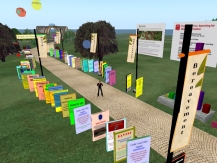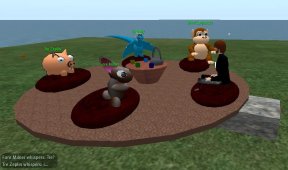 I’m not much for popularity contests, but it is critical to know just who and what is going on in one’s area. For this reason, I installed some simple counters that report to me the number of different avatars per hour…but not their names…for the sake of privacy.
I’m not much for popularity contests, but it is critical to know just who and what is going on in one’s area. For this reason, I installed some simple counters that report to me the number of different avatars per hour…but not their names…for the sake of privacy.
The Path of Support is a place to find out about the wide variety of healthcare support groups in Second Life.
So how is The Path doing?
I now have 3 months worth of data:
Average avatars a day saw a gradual increase. For Jan. it was 7.9, Dec. was 7.3, and Nov was 7.1. (These numbers may be shocking to folks used to website volume, but given the current membership in Second Life and the lack advertising/outreach for The Path…I’ve got to say, I am kinda happy. Secondary to the service it provides, The Path is also learning tool for this sort of project within a virtual world.)
Most avatars in one day for those 3 months was 19. That was the day I posted to the group healthcare@lists.secondlife.com.
Lowest avatars a day was 1, and it wasn’t me!
Most popular day of the week was Fri/Sat.
Popular time of the day is from 9 to 1 SLT.
In December I installed a counter on the note cards that I give away. One Entryway notecard, that details The Path and it’s content, was given for every 8.5 visitors in Jan. In Dec it was 7.3. One calendar notecard, that has some of the groups meetings for the month, was given for every 7.3 visitors in Jan. In Dec it was 5.7. One does not need to receive a notecard inorder to get good information from The Path, but the notecards have more information and show added interest. I hope to see these both increase, but understand at this point, the calendar is probably the most visually compelling.
I have recently begun asking others to put up promotional posters about The Path in other areas of Second Life. I am collecting stats on these posters, but do not have a full month’s worth. At this point all I can say is that a few people are using them.
With the addition of the calendar, extra posters, and organizing the groups, I am trying to make The Path more helpful to people. By providing a better service, I hope to see increased traffic.
Further, there has been ‘outreach’ for the path in real life. VintFalkin had a web based article on the Path and roughly doubled visitors for a couple of days. Wellness published an article I wrote about the Path available both in/out world, and that increased visitors for about a week. A simple post to an Second Life email health list garnered a few visitors for the day.
This year I am participating in the Dreams Community Fair. It features numerous healthcare groups. I have a booth, with informational posters, notecard with landmark, and even a “freebie” to entice folks. I am happy to say that The Path had its biggest day in the last 3.5 months, with 20 visitors. I am interested to see how the rest of the fair goes.
I think The Path can be even more of a service, and look forward to new features as well as working with the other healthcare folks within Second Life and without.
Many thanks to the folks on Healthinfo Island (OK, Carolina Keats) as well as the funders- The Greater Midwest Region of the National Network/National Library of Medicine for the tremendous opportunity to help maintain The Path of Support.




